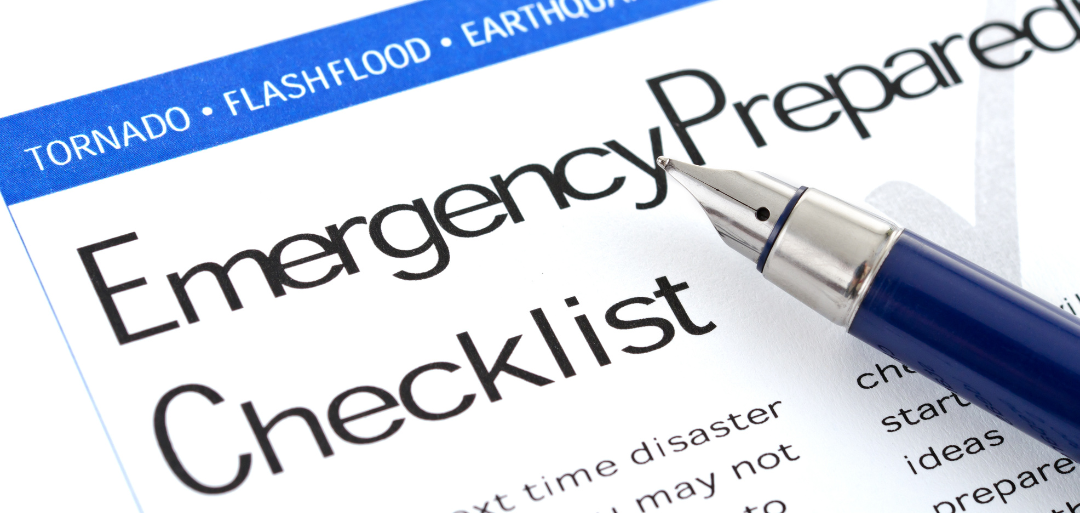Article | Arts Preparedness
Article | Arts Preparedness

EMERGENCY RESPONSE PLANNING
Disaster never strikes at a convenient time. In fact, if you could plan the timing for a disaster, chances are you might still not be ready when it arrives. A good plan will help your organization develop categorized strategies for managing unforeseen circumstances.
If your organization has not been directly affected by a recent crisis, you may be inclined to continue with the status-quo, which often means reacting to issues only as they arise. However, NOW is the time to be pro-active and make a plan for disaster readiness1 so that when tragedy does strike, you are better prepared and your losses can be minimized. If your organization has been affected by a disaster, consider looking at available resources2 to increase your art business or organization’s preparedness as part of your rebuilding process.3
Emergency response plan templates4 can walk your organization step-by-step through the process of preparing for a variety of disruptions to your offerings, whether it be a weather-related disaster, health issue, economic disruption or other catastrophe.
Coordinate Your Efforts
Who will lead your organization’s planning efforts? If you are governed by a Board of Directors, they might choose to create an Emergency Management Committee and designate board members to coordinate emergency planning, training and response, which will free up employees to facilitate on-the-ground efforts. As board members are more likely to be off-site during a disaster, they might be best positioned to be a communications point of contact as well, transmitting critical information to media, volunteers or other recovery teams and contractors. If you do not have a board, consider finding another off-site stakeholder willing to step up and engage in your planning process. Would they be willing to be delegated duties during a disaster?
Building Maintenance and Evacuation Plans
Having regular inspections and maintenance performed on electrical and plumbing issues could help prevent electrical fires or water damage from old or faulty building infrastructure. Do you and your staff members know the building layout for evacuations and where water shut-off valves and breaker boxes are? Ensure that smoke/carbon monoxide detectors, first aid supply kits and fire extinguishers are strategically placed and in working order and always keep emergency exits unblocked. Designate an external location as a meeting point if an evacuation must occur.5
Emergency Employee Notification
In the midst of a disaster, you may need to immediately seek safety either by evacuation or sheltering-in-place and to contact others to do the same. An automated employee notification system could be integrated with employee records and deploy messages across multiple platforms. However, a standard phone tree could be used as a backup if internet fails during a disaster. Always keep a current list of updated contact information for staff and their emergency contacts in multiple places (on the cloud, on your cell phone and in your wallet). A plan like this might ask each person to be responsible for contacting three others to ensure all have reached shelter. You will want to test the phone tree protocols you develop well before disaster strikes.6
Communications Plan
In the event of a disaster, your organization may be bombarded with volunteers seeking to send supplies/donations or media outlets looking for an interview. Establish a disaster communications plan now that includes a list of contact information for local media outlets and designate a primary and alternate individual within the organization to handle all media and volunteer requests. Many will try to engage your business through social media. A comprehensive social media communications plan can help your organization keep your employees, patrons or friends and family quickly informed of current conditions. Crises can be opportunities to give timely public responses that can maintain or restore confidence in your product or services.7
Insurance/Risk Assessment and Disaster Coverage
Consider having a risk assessment completed that can show hidden vulnerabilities so that you can prepare for them. A proper risk assessment will identify potential hazards to your organization, objectively assess your vulnerability (which assets are at risk?) and analyzing what the impacts could be.8 Next you will want to try to mitigate those risks. Having the appropriate insurance coverage is one way to ensure that your assets are protected. For instance, what type of insurance coverage do you currently have? And is it enough to cover losses should tragedy occur? Do you carry full coverage on the vehicle used for art transport or company car? Check out the Business Insurance Guidebook for Artists9 from CERF+ to get targeted advice for your arts business.
Current Inventory
Taking regular inventory of equipment, supplies and stock is recommended and even mandated by most business and nonprofit policies. Guides10 are available to walk your org through the basics of arts inventory collection. Consider the use of inventory management software. Often, inventory can be digitally integrated with point-of-sale and bookkeeping records. You will need to keep these records (including photographs and serial numbers of large equipment) in a safe place (on the cloud, if possible) so that they can be easily accessed after a disaster for insurance claims.
Cloud File Storage
Although most of our daily transactions are now paperless, digital records are still often stored on on-site computer hard drives. For a small monthly fee, cloud storage services provide a safety net for website and software backups, financial documents and other important records. The additional cost will prove invaluable when all else is lost. If your organization hasn’t yet upgraded to newer technologies, now could be the time to adopt cloud-based tools into your procedures like storage, e-signatures, collaboration and increased security permissions that will keep your art business current and running efficiently in today’s digital economy.11
Archives/Collection Storage
Finding available space for collections/ archive storage or treasured keepsakes is tricky. Often, these objects, photographs and documents get archived12 into back rooms as space is needed for current display, performance or retail endeavors. Ensure that any areas where collections are stored are climate controlled and that steps are taken to reduce potential casualty if flooding, fire, pests or other unforeseen disasters hit. You can store items on elevated shelving that is bolted to walls, use plastic storage totes and fireproof safes where applicable and perform regular pest maintenance. If you don’t have a collections manager, build a relationship with an archivist or agency to assess your needs or to call in if preservation or restorations are needed.
Succession Planning
Whether an organization or family-owned art business, take time to consider what would happen if the person or people at the helm or in key positions were incapacitated. Who would take the reins? Does more than one person have access to crucial passwords or accounts? Will you cultivate internal talent to replace an individual after a planned or unexpected departure or conduct an outside search? A clear organizational chart, clearly defined job descriptions and a succession plan will be important to reduce confusion and disagreement after a disaster and provide for clear leadership transition in uncertain times.13
Financial and Strategic Planning and Diversification
A good strategic plan for an arts organization is crucial to securing grant funding. And no strategic plan is complete without a financial plan. However, creating a unified vision for moving forward sustainably presents challenges. You may need to bring in a financial consultant to provide guidance or do some research14 to assess your business plan for financial longevity. Diversity in your offerings may make you or your organization better poised to roll with the punches if a disaster affects one particular revenue stream.
PRACTICE MAKES PREPARED
The preparedness plan your arts organization develops will not be complete until it is practiced and made perfect. Training exercises or drills should be conducted on at least an annual basis in order to give staff confidence to execute the plan and make changes or additions to the plan as required. Employee turnover, changes in building infrastructure and newly implemented technology can make a plan obsolete quickly.
It is recommended to use a trauma-informed approach, especially if your community has experienced prior disasters. Becoming familiar with a disaster response through field training or drills will help your staffers manage their own stress responses under pressure so that they can better communicate with co-workers, clients and the public during traumatic events.15
dPlan and ArtsReady
have a disaster planning subscription service for arts organizations that walk subscribers through disaster preparedness.
The U.S. Government
offers templates online for families and other assistance for the creation of emergency response plans.
CERF+’s Studio Protector Toolkit
helps artists safeguard their studios and careers through planning resources and grant assistance.
https://cerfplus.org/studio-protector/
National Heritage Responders
provide round the clock advice from trained conservators and collections care professionals. Keep their 24/7 hotline number on hand, in case of disaster:
202.661.8068
REFERENCES
- dPlan Disaster Planning Toolkit. https://www.dplan.org/
- CERF+ Studio Protector Toolkit. https://cerfplus.org/studio-protector/
- “An Arts Field Guide to Federal Disaster Relief” National Coalition for Arts’ Preparedness & Emergency Response, National Endowment for the Arts, and The Andrew W. Mellon Foundation. July 2021. https://www.ncaper.org/_files/ugd/4d06be_fc5a673509d54465af09440b487b0e2b.pdf
- “Make a plan” Emergency Response Plan template. U.S. Government website. August 31, 2022. https://ready.gov/plan
- “Evacuation” U.S. Government website. February 18, 2021. https://www.ready.gov/evacuation
- Haria, Bhaven. “A Plan for Crisis Communication: Need of the hour” Computer Weekly website. June 24, 2010. https://www.computerweekly.com/tip/A-plan-for-crisis-communication-Need-of-the-hour/plan
- Fontanella, Clint. “How to Create a Social Media Crisis Management Plan [Free Template]” HubSpot website. May 4, 2022. https://blog.hubspot.com/service/social-media-crisis-management
- “Risk Assessment” U.S. Government website. https://www.ready.gov/risk-assessment
- “Art Business Insurance Guide” CERF+ Studio Protector Guide website. https://cerfplus.org/wp-content/uploads/2016/10/CERF_Insurance_Booklet_8.5X11.pdf
- “How to Take and Inventory of Your Art Studio” https://cerfplus.org/studio-protector/resources/how-to-takean-inventory-of-your-art-studio/
- Jackson, Stephen. “The Non-Profits Guide to Managing Documents in the Cloud” Philanthropy News Digest and TechSoup. https://philanthropynewsdigest.org/features/techsoup-pnd/the-nonprofits-guide-tomanaging-documents-in-the-cloud
- Quinlan-Hayes, Mollie. “Managing and Preserving Your Legacy” THE ARTS ORGANIZATIONS AT A CROSSROADS TOOLKIT: Managing Transitions and Preserving Assets. Section C. National Coalition for Arts’ Preparedness Emergency Response website. https://www.ncaper.org/copy-of-knowledge-assets
- “Succession Planning for Nonprofits - Managing Leadership Transitions” National Council for Non-Profits website. https://www.councilofnonprofits.org/tools-resources/succession-planning-nonprofits-managing-leadership-transitions
- Fisher, Colin. “Financial Planning for Artists: An Overview and Guide”. Symposia website. March 10, 2022. https://www.artsymposia.com/article/financial-planning
- Metzer, Ralph. “The Role of Training in Your Disaster Preparedness Plan”. Occupational Health and Safety Magazine. May 1, 2015. https://ohsonline.com/Articles/2015/05/01/The-Role-of-Training-in-Your-DisasterPreparedness-Plan.aspx


